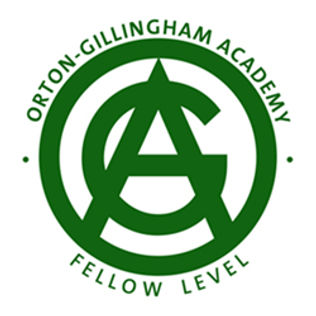Orton - Gillingham
What is the Orton - Gillingham Approach?
The Orton-Gillingham Approach is a direct, explicit, multisensory, structured, sequential, diagnostic, and prescriptive way to teach literacy when reading, writing, and spelling does not come easily to individuals, such as those with dyslexia. It is most properly understood and practiced as an approach, not a method, program, or system. In the hands of a well-trained and experienced instructor, it is a powerful tool of exceptional breadth, depth, and flexibility.
The essential curricular content and instructional practices that characterize the Orton-Gillingham Approach are derived from two sources: first from a body of time-tested knowledge and practice that has been validated over the past 80 years, and second from scientific evidence about how individuals learn to read and write; why a significant number have difficulty in doing so; how having dyslexia makes achieving literacy skills more difficult; and which instructional practices are best suited for teaching such individuals to read and write.

What sets the OGA apart?
The Orton - Gillingham Academy training relies on coursework and practicum delivered by an Academy Fellow. Fellows are certified by OGA as independent practitioners to provide the Academy curriculum.
The OGA has deep roots. It was established by its Founding Fellows, who were either trained directly by Dr. Samuel Orton, Anna Gillingham, Bessie Stillman, June Lyday Orton, Paula Rome or other individuals trained by the previously mentioned individuals. The OGA certifies people to use the Orton-Gillingham Approach with students of any age—pre-k through adult. There is not a rigid scope and sequence but flexibility to honor the Orton-Gillingham Approach’s seminal works.
In OGA training it is essential that the teacher/tutor understand how to use and implement the OG teaching techniques and procedures. It involves how to teach/remediate all areas of literacy, not just reading and spelling, and providing this instruction one-on-one, in a classroom, or with any size group. OGA Fellows provide the knowledge-base with our coursework and the practical experience and support learning how to apply the knowledge-base.
What is the difference between the Associate level and Classroom Educator level?
The Orton - Gillingham Academy has different memberships levels.
The Classroom Educator level is a 30 hour training that focuses on the fundamental principles of the OG approach. Participants will engage in understanding the characteristics of the dyslexic learner as well as learn about specific strategies, procedures, and lesson planning for teaching those whom reading and spelling does not come easy. This training primarily prepares participants to provide and adapt literacy instruction for the whole class or for small groups needing supplemental support. Classroom Educator is not a prerequisite for Associate Training. Teachers who are general education teachers should take the Classroom Educator level. Teachers who complete the Classroom Educator level are not permitted to tutor after the completion of the course and practicum.
The Associate level is a 70 hour course that also covers all fundamental principles, strategies, and procedures of the OG approach. Additionally, in this course, participants are able to take a deeper dive into systematic and explicit instruction with vocabulary, comprehension, fluency, morphology, and more. This training is intended for practitioners working with struggling readers of all ages, including those with dyslexia, in individual or group settings. This course is for special education teachers, reading specialists, and those who are interested in tutoring.

Frequently Asked Questions
Which course should I take?
If you are interested in tutoring or working with students with Dyslexia you should take the Associate level course.
The Associate course is the starting point for reading interventionists, special education teachers and those wishing to tutor.
The Classroom Educator level is intended for educations in a general education setting. The Classroom Educator practitioner is certified by OGA to provide and adapt literacy instruction for the whole class or for small groups needing supplemental support.
What is the structure of the virtual coursework?
Trainees will receive copies of the slides and access to a Google Classroom with hundreds of resources. Trainees at the Associate level are required to complete the OGA Subscriber course ahead of the training.
The majority of the training (over 80%) is completed live on Zoom. Trainees are required to attend 100% of the training. There will be opportunities to use manipulatives, practice in breakout rooms and teach lessons.
What does the practicum entail?
At the Associate Level
100+ lessons working with a 1:1 student
1 lesson with a student at a minimum of 40 minutes in length, ideally 45-60 minutes
Lessons occur 2x a week (minimum) on nonconsecutive days.
A minimum of 8 consecutive months
A minimum of 10 observations with the same Practicum Student
At the Classroom Educator Level
50+ lessons working with a class or a group of students (2 or more)
1 lesson with a group at a minimum of 40 minutes in length, ideally 45-60 minutes
Lessons occur 2x a week (minimum) on nonconsecutive days.
A minimum of 5 observations over a minimum of 8 months (5 months must be consecutive)
How does the practicum work virtually?
The trainee video records a lesson with their student and then sends the recording to the Fellow for review. The trainee also sends associated lesson materials including all student work, so the Fellow can see what the student worked on during the lesson. Once the Fellow has reviewed the lesson Fellow will send written feedback and schedule a follow-up meeting with the trainee. This process occurs a minimum of 10x during the Associate practicum and a minimum of 5x during the Classroom Educator practicum.
What is the timeline for the practicum?
The trainee should begin the practicum as soon as possible (ideally within 2 -3 months of completing the coursework).
The practicum starts when the coursework is completed and your student has been approved by Jen.